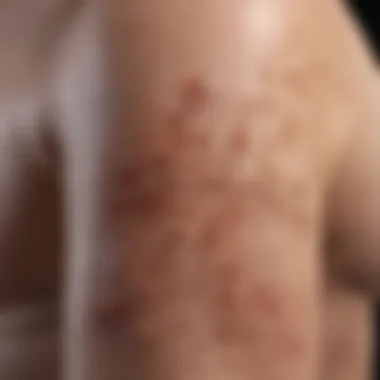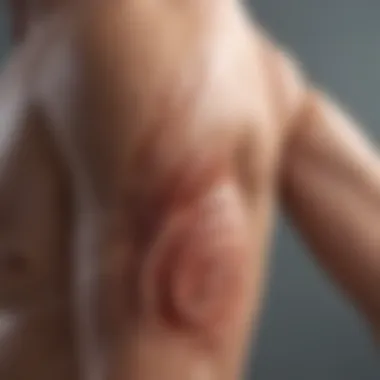Understanding Chronic Itchy Arms: Causes and Management


Summary of Objectives
The objective is to provide a detailed examination of the factors leading to chronic itchiness in the arms. It encompasses dermatological conditions such as eczema and psoriasis, systemic disorders like diabetes and liver disease, as well as environmental triggers.
Importance of the Research
Understanding chronic itchy arms is crucial due to the multifaceted nature of the symptoms. The research delves beyond just the physical manifestations, also considering psychological effects and the social implications of living with this condition. It aims to equip professionals and individuals with the knowledge necessary for effective management.
Causes of Chronic Itchy Arms
Chronic itchiness can stem from diverse causes. Here are some common categories:
- Dermatological Conditions: Eczema, psoriasis, and contact dermatitis are notable contributors. They are often characterized by inflammation and skin barrier dysfunction.
- Systemic Disorders: Conditions such as hypothyroidism, diabetes, and kidney failure can manifest as itchiness without a concurrent rash.
- Allergies: Environmental allergens or food allergens can lead to itchy sensations. Histamines released during allergic responses can cause widespread discomfort.
- Infections: Fungal, bacterial, or viral infections can result in itchiness as the body responds to these pathogens.
- Psychological Factors: Stress and anxiety may exacerbate itchiness, making it a psychological phenomenon as much as a physical one.
Diagnosis
Diagnosis typically involves a multi-faceted approach, which may include:
- Physical Examination: This allows the healthcare provider to assess the skin and identify visible signs.
- Patient History: A thorough discussion of symptoms, onset, and any possible triggers is crucial.
- Laboratory Tests: Blood tests, allergy tests, or skin biopsies may be required to rule out systemic diseases or confirm specific conditions.
Management Strategies
Effective management involves a combination of treatment options tailored to the individual’s specific needs. Here are prominent strategies:
- Topical Treatments: Corticosteroids or moisturizers can alleviate symptoms by reducing inflammation and improving skin hydration.
- Systemic Medications: For severe cases, oral antihistamines or immunosuppressants might be advised.
- Lifestyle Modifications: Identifying and avoiding triggers are essential. Stress management can also play a role in reducing symptoms.
- Professional Guidance: Consulting with dermatologists, allergists, or primary care physicians ensures a comprehensive approach to managing chronic itchiness.
"A nuanced understanding of both physical symptoms and psychological implications is vital for the management of chronic itchy arms."
Results and Discussion
Presentation of Findings
The prevalence of chronic itchy arms often correlates with common dermatological conditions. Studies indicate that individuals with eczema are especially prone to itch. Additionally, psychological factors cannot be overlooked; surveys show a significant percentage of individuals report heightened itchiness during stressful periods.
Implications of Results
These findings underscore the importance of a holistic treatment approach. Addressing both physical and psychological components can significantly improve the quality of life for affected individuals. Future research must continue to explore the interplay between various causes of chronic itchiness and develop integrated management protocols.
Epilogue
In summary, chronic itchy arms pose a complex challenge, intertwining dermatological, systemic, and psychological aspects. A thorough understanding of the condition can lead to more effective management strategies, benefiting those affected.
Intro to Chronic Itchy Arms
Chronic itchy arms represent a persistent discomfort that many individuals experience, often impacting their daily lives and overall well-being. Understanding this condition is essential, not just for those afflicted, but for health care providers as well. Itchy arms can be symptomatic of various underlying issues, necessitating a comprehensive exploration into its causes, diagnosis, and management strategies. For patients, recognizing the significance of chronic itch can lead to earlier intervention and better outcomes. Moreover, the subject intersects multiple fields of study, including dermatology, psychology, and even environmental health, thereby broadening its relevance.
Definition and Overview
Chronic itchy arms is characterized by a prolonged sensation of itchiness affecting the arms, often described as bothersome and relentless. The condition may extend beyond mere irritation, hinting at deeper medical concerns. Understanding this phenomenon requires a clear definition, specifying that chronic means an itch lasting for more than six weeks. The sensation can be localized or generalized, depending on its etiology. The itch cycle often aggravates skin conditions, leading to further complications such as scratching-induced injuries or infections. Information about this condition is not just beneficial for those directly affected but also critical for clinicians aiming to address its multifaceted nature effectively.
Prevalence and Demographics
Research indicates that chronic itch is a common complaint among the general population. While specific statistics on itchy arms can vary, studies suggest that upward of 20% of adults may experience some form of chronic itching at some point in their lives. Furthermore, certain demographics, such as individuals over the age of 60 or those with pre-existing skin conditions like eczema or psoriasis, are more susceptible. Gender may also play a role, with women reportedly seeking treatment for itch-related issues more frequently than men. Recognizing the prevalence of chronic itchy arms helps health professionals prioritize patient education and resource allocation in addressing this condition.
Common Causes of Chronic Itchy Arms
Understanding the common causes of chronic itchy arms is crucial for identifying effective management strategies. Many individuals experience this issue, yet often overlook the underlying factors contributing to it. By providing a detailed overview of specific causative elements, this section allows readers to grasp the multifaceted nature of this condition. Awareness of these causes can significantly aid in diagnosis and tailored management.
Dermatological Conditions


Chronic itchy arms can stem from various dermatological conditions. Skin disorders are among the most prevalent causes and can indicate more serious issues. Conditions such as eczema, psoriasis, and contact dermatitis frequently lead to persistent itching.
- Eczema: This condition often manifests as dry, inflamed patches on the skin, which can cause significant discomfort.
- Psoriasis: Characterized by red, scaly patches, psoriasis can also lead to severe itching, particularly around the elbows and other flexural areas.
- Contact Dermatitis: This occurs when skin reacts to irritants or allergens, leading to localized itchiness. Common triggers include certain soaps, detergents, and fabrics.
Correctly identifying the dermatological condition is essential, as treatments vary widely based on the diagnosis.
Allergic Reactions
Allergic reactions can trigger chronic itching as well. The immune system's heightened response to certain substances can lead to itchiness in the arms. Common allergens include:
- Food: Certain foods like nuts, eggs, or shellfish can lead to generalized itching, sometimes in localized areas.
- Pollen: Seasonal allergies can cause discomfort and persistent itching.
- Insect Stings or Bites: Reactions to insect bites can lead to localized swelling and itching.
Recognizing and avoiding known allergens can alleviate symptoms significantly. Additionally, a consultation with an allergist might be necessary for identifying triggers accurately.
Systemic Disorders
Another important aspect involves systemic disorders that manifest with skin-related symptoms, including itchiness.
- Diabetes: Itching can be due to dry skin resulting from diabetes complications.
- Thyroid Disorders: An underactive or overactive thyroid can cause skin changes and subsequent itching.
- Liver Disease: Conditions affecting the liver can result in a buildup of bile salts, leading to intense itching.
Diagnosis regarding these systemic issues typically requires thorough clinical assessment, including laboratory tests to determine the underlying condition.
Environmental Factors
Environmental factors can also play a role in causing chronic itchy arms. These factors often include:
- Climate: Extreme weather conditions, both hot and cold, can dry out skin, leading to irritation and itchiness.
- Humidity: High levels of humidity can contribute to skin conditions that cause itchiness, such as fungal infections.
- Pollution: Prolonged exposure to pollutants can irritate the skin, exacerbating existing conditions.
Understanding these environmental influences can assist individuals in managing their symptoms more effectively. Adjusting lifestyle and environmental factors may offer substantial relief for affected persons.
Diagnosis of Chronic Itchy Arms
Diagnosing chronic itchy arms requires a systematic approach, as the condition can arise from numerous underlying causes. Establishing an accurate diagnosis is paramount not only to address the immediate discomfort but also to ensure proper long-term management. Diagnosis typically involves a detailed history and physical examination, guiding medical professionals in identifying contributing factors and tailoring a suitable treatment plan.
Clinical Evaluation
A comprehensive clinical evaluation is the cornerstone of diagnosing chronic itchy arms. Physicians begin by gathering a thorough medical history, which includes family history, exposure to allergens, and lifestyle factors that may contribute to skin irritation. Questions might explore recent changes in soap, detergent, or skincare products. This inquiry helps in identifying potential allergens or irritants.
Physical examination requires careful inspection of the affected skin. Observations may include:
- Rashes: Erythema or discoloration might indicate certain dermatological conditions.
- Lesions: The presence of plaques or blisters can signify conditions like psoriasis or eczema.
- Skin Texture: Dry or scaly skin may suggest xerosis, a common cause of itchiness.
The clinician will also look for signs of scratching, which may lead to secondary infections. By analyzing these factors, a more precise diagnosis can be achieved. This evaluation facilitates distinguishing between various etiologies and can direct the selection of further testing if necessary.
Laboratory Tests
While a clinical evaluation provides significant insights, laboratory tests can be indispensable for a definitive diagnosis. These tests can confirm or rule out specific conditions that may not be evident during physical assessments. Some common laboratory investigations include:
- Skin Biopsy: This procedure involves removing a small section of affected skin. A biopsy can help diagnose conditions such as dermatitis, infections, or malignancies.
- Patch Testing: Used for allergic contact dermatitis, this test identifies specific allergens by applying small amounts of various substances to the skin and observing reactions.
- Blood Tests: Complete blood counts or specific IgE tests may indicate allergic responses or underlying systemic conditions, like liver or kidney issues.
"Accurate diagnosis not only eases symptoms but also addresses the root cause of the condition."
Aside from these specific tests, clinicians might recommend stool tests if systemic disorders are suspected. A multifaceted approach ensures thorough investigation, allowing practitioners to develop effective management strategies based on empirical evidence.
Impact on Quality of Life
Chronic itchy arms can significantly affect an individual’s quality of life. This impact can be both physical and psychological, altering daily routines, social interactions, and overall emotional well-being. The ways in which this condition disrupts life necessitate a comprehensive understanding and consideration of its effects.
Physical Discomfort
The physical discomfort arising from chronic itchiness can be debilitating. Individuals may experience persistent scratching, which can lead to skin damage, secondary infections, or even scarring. The itch itself can interfere with sleep quality, leading to fatigue during the day. This fatigue can diminish the ability to perform both work and leisure activities.
Research suggests that a significant portion of patients report difficulties in focusing on tasks at work or school due to the persistent distraction of irritation. As a result, this discomfort can create a cycle of decreased productivity, increased stress, and worsened symptoms.
In many cases, individuals may alter their lifestyles to cope with discomfort. For example, they may avoid certain fabrics or environments that trigger their symptoms. This avoidance can further limit social interactions and activities that promote well-being.


Psychological Effects
The psychological impact of living with chronic itchiness can often be as severe as the physical symptoms. Those affected may experience feelings of frustration, helplessness, or embarrassment. The visible effects of scratching, like redness or open sores, can lead to social anxiety and avoidance of public situations.
Research indicates that individuals with chronic itching often report higher levels of distress and anxiety compared to the general population. Sleep disturbances stemming from itchiness may also contribute to mood disorders such as depression or anxiety disorders. The emotional toll can hinder personal relationships and diminish overall life satisfaction.
"Chronic itch not only affects the skin but also infiltrates the mental and emotional states of those suffering from it."
As such, addressing the psychological aspects is equally essential as managing the physical symptoms. Understanding this interconnectedness helps in formulating a holistic approach to treatment, aiming for enhancements in both physical comfort and mental well-being.
Management Strategies
Management strategies for chronic itchy arms are essential in addressing the discomfort associated with this condition. Effectively managing symptoms can lead to significant improvements in a person’s quality of life. Understanding the multifaceted nature of chronic itch allows for more targeted interventions. This section discusses various management strategies, focusing on topical treatments, oral medications, and lifestyle modifications.
Topical Treatments
Topical treatments are often the first line of defense against chronic itchy arms. They include corticosteroids, calcineurin inhibitors, and moisturizers. Corticosteroids help reduce inflammation and itchiness. They are effective but should be used with caution due to potential side effects like skin thinning with long-term use.
Calcineurin inhibitors such as tacrolimus and pimecrolimus are non-steroidal options that can be useful, especially in sensitive areas. Regular use of moisturizers is fundamental as they help to maintain skin hydration, preventing further irritation. People may benefit from using occlusive dressings to enhance the effectiveness of topical medications.
"Topical treatments can provide quick relief but should be integrated within a comprehensive management plan for lasting results."
Oral Medications
Oral medications can be crucial for managing chronic itch when topical treatments are insufficient. Antihistamines are commonly prescribed to alleviate itching, especially if allergies contribute to the condition. Non-sedating antihistamines like cetirizine or loratadine are preferred during the day for minimizing drowsiness.
In more severe cases, systemic corticosteroids or immunosuppressants like cyclosporine may be considered. However, careful monitoring is necessary due to potential side effects. Additionally, some newer biologic medications may offer promise in treating chronic itch associated with underlying systemic conditions.
Lifestyle Modifications
Lifestyle modifications can have a profound effect on managing chronic itchy arms. Identifying and avoiding irritants, such as certain soaps or fabrics, is crucial. It is important to adopt a gentle skin care routine that includes using fragrance-free products.
Stress management techniques like yoga or meditation may also play a role in reducing symptoms. Keeping the nails short and wearing protective gloves can prevent skin damage from scratching. Staying hydrated and maintaining a balanced diet supports overall skin health.
Preventive Measures
Understanding preventive measures is essential in managing chronic itchy arms effectively. Identifying and mitigating triggers can significantly reduce flare-ups. The proactive approach in prevention can lead to healthier skin and an overall better quality of life. These measures can be particularly useful for individuals who experience persistent itching due to various conditions.
Identifying Triggers
Recognizing triggers plays a significant role in preventing chronic itching. Triggers are specific factors or substances that can cause or exacerbate skin irritation. These might include:
- Allergens: Common allergens like pet dander, pollen, and specific foods can provoke an immune response, leading to itchy skin.
- Irritants: Substances such as harsh soaps, laundry detergents, or environmental pollutants can irritate the skin and cause discomfort.
- Weather Conditions: Extreme temperatures, humidity, or dryness can also trigger symptoms. For example, low humidity can lead to dry skin, intensifying itchiness.
- Stress: Emotional factors are often overlooked but can have a direct impact on skin health. Stress can lead to heightened sensitivity and worsen itching.
To effectively identify triggers, individuals should maintain a symptom diary. This involves documenting the time of occurrences, environmental conditions, product use, and emotional states. Recognizing patterns in this way helps in narrowing down possible triggers, which in turn facilitates more targeted prevention strategies.
Skin Care Regimens
Implementing a consistent and suitable skin care regimen is crucial for individuals dealing with chronic itchy arms. A well-structured skin care routine can restore moisture and protect the skin barrier. Here are important elements to consider:
- Moisturization: Regular use of emollients such as lotions or creams helps keep the skin hydrated. Products containing ingredients like glycerin or hyaluronic acid can be particularly effective.
- Gentle Cleansing: Opt for gentle, non-irritating cleansers. Avoid soaps with strong fragrances or harsh chemicals that may further aggravate the skin.
- Sun Protection: Exposure to harmful UV rays can lead to skin damage and enhance itchiness. Use a broad-spectrum sunscreen with an SPF of at least 30.
- Avoiding Hot Water: Hot showers or baths may strip the skin of natural oils, leading to increased dryness and itchiness. It’s better to use lukewarm water and limit bath duration.
- Retention of Moisture: Apply moisturizers immediately after bathing when the skin is still damp. This helps lock in moisture and can significantly improve skin hydration.
Proper skin care acts as a preventative shield against potential irritants and protects the skin's natural barrier, thereby reducing instances of chronic itching.
When to Seek Professional Help
Determining when to seek professional help for chronic itchy arms is critical. The condition can be indicative of underlying health issues that may progress without appropriate intervention. Recognizing the signs that warrant medical attention can profoundly affect the management and outcome of the condition.
Identifying Serious Conditions


Chronic itchiness can sometimes signal more serious health concerns. Conditions such as eczema, psoriasis, or dermatitis may initially appear to be minor irritations. However, if the itch persists despite basic care, it may indicate a need for further investigation. Additional symptoms that may accompany itchy arms include:
- Persistent redness or swelling
- Skin lesions that ooze or bleed
- Unexplained weight loss or fatigue
- Changes in skin texture or color
If you experience these signs alongside itchiness, it is advisable to consult a healthcare provider. Early detection can prevent complications and lead to a timely, effective treatment plan. In certain cases, systemic disorders, such as liver disease or thyroid dysfunction, may also manifest as skin irritation.
Consultation Guidelines
When deciding to consult a healthcare professional, consider these guidelines:
- Gather Information: Before the appointment, keep a record of your symptoms. Noting when the itch began, any exacerbating factors, and previous treatments can provide valuable context for your healthcare provider.
- Choose the Right Specialist: Depending on the severity and nature of your symptoms, you might first consult a dermatologist. They specialize in skin disorders and can offer targeted treatment or referrals to other specialists.
- Be Transparent: During the consultation, be open about your symptoms and concerns. Share detailed information about your medical history and any medications you currently take.
- Ask Questions: Inquire about possible causes and treatment options. Understanding your condition is vital for effective management.
- Follow Up: If a treatment plan is initiated, attend follow-up appointments to monitor your progress. Adjustments may be necessary based on your response to treatment.
Seeking professional help for chronic itchy arms is not just about alleviating discomfort; it is about safeguarding your overall health.
Research and Narrative on Chronic Itchy Arms
Research on chronic itchy arms plays a crucial role in comprehending this multifaceted condition. Understanding its causes and management is essential for both medical professionals and patients. The insights gained from scholarly work and clinical narratives contribute significantly to developing effective treatments and preventive strategies. A deeper investigation into this topic allows for the identification of the various dermatological, systemic, and environmental contributors that lead to chronic itchiness.
In the realm of chronic itchy arms, the interplay of literature review and recent findings merges to create a solid foundation for future exploration. This understanding not only enhances patient care but also addresses psychological ramifications associated with chronic itching. Research efforts, therefore, focus on providing a systematic approach to diagnosing and treating the underlying issues of chronic itchiness, which ultimately benefits the quality of life.
This section will delve into the ongoing body of work available in the literature, showcasing how founder studies can enhance knowledge in this area and highlight gaps that affect clinical practice.
Literature Review
The literature regarding chronic itchy arms encompasses a wide spectrum of studies spanning from clinical case reports to extensive epidemiological research. Various studies have documented the patterns of itchiness associated with different conditions, such as eczema, psoriasis, and other skin disorders. Furthermore, investigations into allergic reactions illustrate the connection between irritants and chronic itching.
- Key Areas of Focus:
- Dermatological conditions and their correlation with itch
- Allergies and reactions to specific elements
- Systemic disorders, including liver and kidney issues
- Environmental factors contributing to itchiness
Despite advancements in understanding chronic itching, there remain gaps in the literature. Often, the relationship between psychological stress and chronic itching is overlooked. This necessitates more comprehensive studies that can address both the physical and emotional impacts of the condition, considering the biopsychosocial model.
Recent Findings
Recent findings in the area of chronic itchy arms highlight the progress achieved in understanding this condition but also underline the need for continued research. Innovations in genetics and dermatology have paved the way for targeted therapies that can alleviate symptoms.
Recent studies indicate:
- The effectiveness of new topical treatments that reduce inflammation and itchiness
- The rise of biologic therapies that target specific pathways involved in chronic itching
- The importance of individualized skincare regimens that consider personalized factors
Clinical Evidence:
Research has consistently underscored the importance of correctly identifying triggers and employing multi-disciplinary approaches in management.
"New treatment modalities must incorporate an understanding of the psychological impacts of chronic itch, as emotional well-being is intertwined with physical health."
Culmination
In the context of chronic itchy arms, the conclusion serves as a critical synthesis of key insights gathered throughout the article. It is essential to recognize that understanding this condition involves grasping the intricate interplay of various factors, including dermatological, systemic, and environmental influences.
The conclusions drawn from the discussions earlier highlight several benefits to comprehending chronic itchy arms. First, it provides a clearer picture of potential causes, fostering early recognition and appropriate diagnosis. Second, it empowers individuals to advocate for their own health by understanding when to seek professional help and what management strategies may be beneficial. Furthermore, addressing the psychological impact of chronic itchiness can lead to more holistic treatment plans that acknowledge both physical ailments and mental well-being.
By appreciating the nuances of chronic itchy arms and considering future directions in research, health professionals and researchers can work to advance knowledge and treatment options, ultimately improving patient care. Such considerations are indispensable in a multidisciplinary approach to manage and potentially mitigate the burden of this affliction.
Summary of Insights
A summary of the insights gained throughout the article illustrates the multifaceted nature of chronic itchy arms. Key insights include:
- Causes: Understanding varied origins, from dermatological conditions like eczema to systemic issues such as liver disease, is crucial for diagnosis.
- Diagnosis: The importance of clinical evaluations and laboratory tests ensures proper identification of the underlying causes of itchiness.
- Management: Effective management must integrate topical treatments, systemic medications, and lifestyle changes tailored to the individual’s needs.
- Psychological Aspects: Recognizing the emotional toll chronic itch can take on an individual underscores the necessity of a comprehensive approach to treatment.
Through these insights, we advocate for a broader awareness of the condition, urging individuals to seek knowledge and support for effectively managing chronic itchy arms.
Future Directions in Research
The future of research into chronic itchy arms offers promising potential for both understanding and treatment. Areas warranting further exploration include:
- Molecular Mechanisms: Investigating the biological pathways that lead to chronic itching could unveil new therapeutic targets.
- Longitudinal Studies: Long-term studies could clarify the relationship between chronic itch and associated psychological conditions, enhancing holistic treatment methods.
- Innovative Treatments: The examination of new pharmacological options and integration of alternative therapies remains critical to providing diverse solutions for affected individuals.
- Impact of Lifestyle: Further research into how environmental and lifestyle factors contribute to chronic itch may inform preventive strategies.
Overall, continued exploration in these areas can enhance understanding, leading to improved clinical practices and patient outcomes regarding chronic itchy arms.















